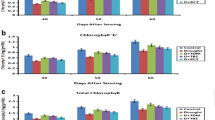Abstract
Impact of fusariotoxins mixture (moniliformin, fiimonisin B1, fusaproliferin, zearalenone, zearalenol and deoxynivalenol, each at concentration 35 μg·mL−1) on maize plants of resistant (Lucia) and susceptible (Pavla) cultivars was studied. After 72 hours of root exposure to the fiisariotoxins the biomass production with both cultivars was approximately 6% lower than in the respective controls. In the resistant cultivar, chlorophyll content was higher comparing to control, with greater increase in chlorophyll b. In the susceptible cultivar, chlorophyll content was slightly decreased, particularly with chlorophyll b. In toxins treated plants, the young root cells were more vacuolated and plasmolysis occurred in the cells of outer cortex.
The cells contained numerous osmiophilic globules in periplasmic space associated with plasmodesmata and plasma membrane, and within cytoplasm associated with membranes of ER, plastids, and tonoplast. In the leaves of the susceptible cultivar also disorganization of thylakoids in some chloroplasts was observed when treated by fiisariotoxins mixture.
Similar content being viewed by others
References
Bandurska, H., Chelkowski, J., & Wisniewska, H. (1994) Free proline accumulation in wheat seedlings influenced by Fusarium culmorum infection and the pathogen metabolite deoxynivalenol. Acta Physiol. Plant., 16:111–116.
Bottalico, A. (1998) Fusarium diseases of cereals: Species complex and related mycotoxin profiles in Europe. J. Plant Pathol, 80: 85–103.
Čiamporová, M. & Mistrik I. (1993) The ultrastructural response of root cells to stressful conditions. Environ. Exp. Bot., 33, 11–26.
Desjardins, A.E., & Hohn, A.E. (1997) Mycotoxins in plant pathogenesis. Molecular Plant-Microbe Interactions, 10, 147–152.
Chauhan, R.S., Singh, B.M., & Develash, R.K. (1997) Effect of toxic compounds of Exserohilum turcicum on chlorophyll content, callus growth and cell viability of susceptible and resistant inbred lines of maize. J. Phytopath., 145, 435–440.
Eudes, F., Collin J., Riox, S., & Comeau, A. (1997) The trichothecenes, a major component of wheat scab pathogenesis. Cereal Res.Comm. 25, 494–495.
Ilarsan, H., & Dolar, F. S. (2002) Histological and Ultrastructural Changes in Leaves and Stems of Resistant and Susceptible Chickpea Cultivars to Ascochyta rabiei. J.Phytopathol. 150, 340–348.
Lamprecht, S. C., Marasas, W. F. O., Alberts, J. F., Cawood, M. E., Gelderblom, W. C. A., Shepard, G. S., Thiel, P. G., & Calitz, F. J. (1994) Phytotoxicity of fiimonisins and AAL - toxin to corn and tomato. Phytopathology, 84, 383–391.
Nadubinská, M., Ritieni, A., Moretti, A., Šrobárová, A. (2003) Chlorophyll content in maize plants after treatment with fùsariotoxins. Biologia, Bratislava, 58, 115–119.
Pastiročk, M., Lemmens, M., & Šrobárová A. (2002) Differences in the reaction of maize hybrids to Fusarium ears rot (F. graminearum Schwabe). In: Disease resistance in plant pathology. 6th Conference of European Foundation for Plant Pathology, Book of abstracts, 2002. p. 100.
Ristic, Z., & Ashworth, E.N. (1993) Changes in leaf ultrastructure and carbohydrates in Arabidopsis thaliana L. (Heyn) cv. Columbia during rapid cold acclimation. Protoplasma, 172, 111–123.
Ritieni, A., Fogliano, V., Randazzo, G., Scarallo, A., Logrieco, A., Moretti, A., Mannina, L., & Bottalico, A. (1995) Isolation and characterization of fusaproliferin, a new toxic metabolite from Fusarium proliferatum. Nat. Toxins, 3, 17–20.
Shi, J., Mueller, W.C., & Beckman, Ch. (1991) Ultrastructure and histochemistry of lipoidal droplets in vessel contact cells and adjacent parenchyma cells in cotton plants infected by Fusarium oxysporum f.sp. vasinfectum. Physiol.Mol.Plant Pathol., 39, 201–211.
Šamajová, O., Šamaj, J.,Volkmann,D., Edelmann, H.G. (1998): Occurrence of osmiophilic particles is correlated to elongation growth of higher plants. Protoplasma, 202. 185–191.
Šrobárová, A. & Erdelská, O. (1999) The growth of maize and wheat embryo in fusariotoxins medium. Proceedings of V. Workshop “New results in genetics, breeding of the agricultural plants”, 136–138.
Šrobárová, A., Moretti A., Ferracane R., Ritieni A., Logrieco A., (2002). Toxigenic Fusarium species of Liseola section in pre-harvest maize ear rot, and associated mycotoxins in Slovakia. European Journal of Plant Pathology, 108 (4):299–306.
Vernon, L.P. (1960) Spectrophotometric determination of chlorophylls and pheophytins in plant extracts. Analyt. Chem. 32, 1144–1150.
Vianello, M., & Macri, F. (1978) Inhibition of plant cell membrane transport phenomena induced by zearalenone. Planta, 143, 51–57.
Author information
Authors and Affiliations
Corresponding author
Rights and permissions
About this article
Cite this article
Šrobárová, A., Nadubinská, M. & Čiamporová, M. Relative Efficacy of Fusamotoxins on Young Maize Plants. CEREAL RESEARCH COMMUNICATIONS 32, 241–248 (2004). https://doi.org/10.1007/BF03543305
Received:
Accepted:
Published:
Issue Date:
DOI: https://doi.org/10.1007/BF03543305




